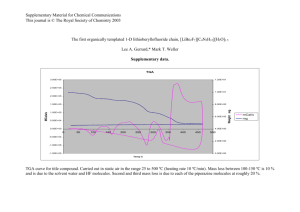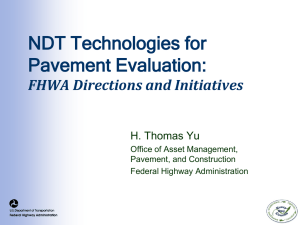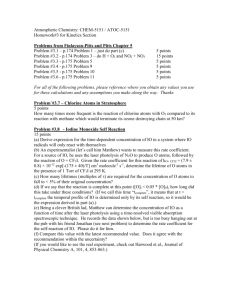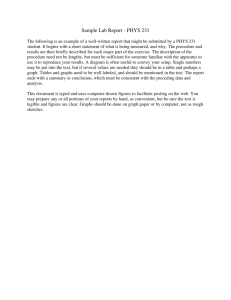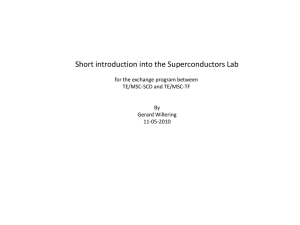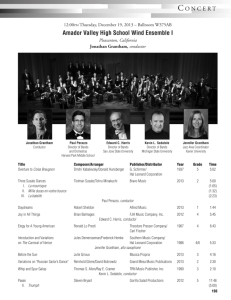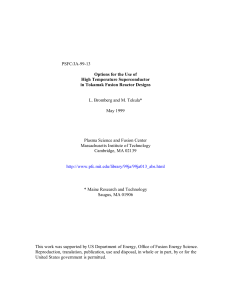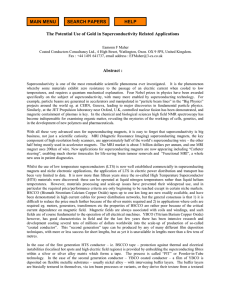Power Point
advertisement
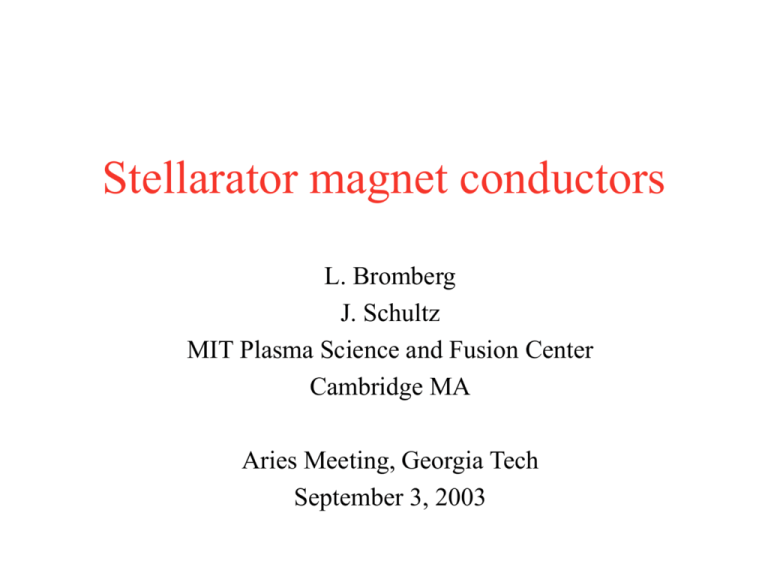
Stellarator magnet conductors L. Bromberg J. Schultz MIT Plasma Science and Fusion Center Cambridge MA Aries Meeting, Georgia Tech September 3, 2003 Organization of talk • Status of HTS/comparison with LTS • Design optimization of LTS • Cost comparison HTS Superconductor options and comparison with LTS (YBCO tape at 4 K and at 75 K) "Un-Critical" Critical Current Density, A/mm2 100000 At 4.2 K Unless Otherwise Stated YBCO Tape 10000 YBCO Tape 75 K Bi2212 Tape ARIES RS Bi2223 Round 4.2K 1000 NbTi Nb3Sn High AC Loss 1.8 K ITER-Nb3Sn Nb-Ti-Ta Nb3Al Low AC Loss Bi2223 Round 75 K 100 0 Courtesy of Lee, UW Madison 5 10 15 T Applied Field, 20 25 SC for modular coil-4 Status of industry • Japan/US/EU continue to support industry – In US, mainly for power applications (motors, generators, fault limiters, transmission lines) • In the US, American Superconductor – Dropping all but YBCO – Hopes to hit 10-20 $/kA m (competitive with copper) • Japan, Europe supporting others (2212) LANL IBAD, Peer review 7/03 AMSC, ORNL RABiT, Peer Review 7/03 LANL, ER Peer review 7/03 AMSC, ORNL conductor development ER Peer review 7/03 Stability margin for low Tc superconductors ~ 100’s mJ/cm3 (3 orders of magnitude smaller) Y. Iwasa, MIT Quench propagation For low Tc, quench propagation velocity is ~10 m/s (3 orders of magnitude larger) M. Gouge, ORNL Stabilizer • In order to allow for proper cooling of HTS in region of poor superconductivity, M. Gouge recommends 5 mW/m resistive shunt (7/03) • This decreases substantially the current density Desired minimum resistivity Copper resistivity @ 77 K Width Thickness • 5.00E-03 Ohm/m 2.57E-09 Ohm m 0.01 m 5.14E-05 m For ARIES-stellerator: no shunt material, beyond that required for manufacturing HTS conductor current density • YBCO and related 123 materials have texturing issues that decrease current density with thickness. • Thickness of superconductor is ~ 1-2 microns • Thickness of structure (Ni-based materials, either Ni, NiW or Hastelloy) is ~ 400-500 microns. • Current density in conductor is 2 orders of magnitude smaller than superconductor • But – Likely that SC can be deposited in much thinner substrates – If 50 microns, drop in current density only 1 order of magnitude HTS as of 7/03 • Dependence of properties on YBCO thickness – Jc ~ 1/d1/2 – Ic ~ d1/2 • The best YBCO result to date (77 K) – for thick(2.9 µm) on IBAD-YSZ Ic ~ 270 A/cm – reel-to-reel RABiTS, 188 A/cm is for a 2.4-µm-thick coating, although one 1.37-µm-thick film exhibited an Ic = 219 A/cm, in 10 m long section • Best properties for YBCO at 77K: – Jc ~ 2 MA/cm2 in 0.35-µm-thick for IBAD-MgO. – Jc ~ 3 MA/cm2 in 0.9µm for RABiTS ARIES-Stellarator magnet concept • For assembly/maintenance, Mallang proposes structural trenches where conductor is inserted Wendelstain 7X Magnet structure concept Instead of individual forms for magnet structure, shells with trenches used for structure Wendelstein 7-X Low temperature magnet • Use grading to decrease cost – Use NbTi in regions of low field (< 7 T) – In regions of higher field, use Nb3Sn or equivalent • Problem: – To wind stellerator magnets with Nb3Sn, it is needed to use react and wind method – Magnets too complicated for applying insulation/bonding after winding (wind & react) • Solution: Use high Tc material at low Tc High Tc (at low temperature) • Justin Schwartz (ARIES-1), now at FSU HFNML (Tallahassee, FL) – It all started here (actually, in UCLA)!!! • Record field, energy, number of turns – BSCCO 2212 HTS insert 5.19 5.13 5.08 Background 18 19 19.94 Total 23.19 24.13 25.02 Oxford/NHMFL HTS insert BSCCO 2212 “Fusion should not have to wait for High Temperature Superconductor” Comment made by a leader of the magnet fusion technology activity to Justin Schwartz LTS design of conductor Magnetic field SC current density T A/m^2 10 4.00E+09 12 3.00E+09 J2 tau tau Current density in Copper (A/m^2)s s A/m^2 5.00E+16 2.00E+00 2.24E+08 5.00E+16 2.00E+00 2.24E+08 0.25 0.25 3.98E+07 8.00E+08 4.97E-02 5.73E+07 8.00E+08 7.16E-02 9.70E-02 1.38E-01 2.12E+08 1.59E+08 1.43E+08 2.08E+08 1.56E+08 1.35E+08 Helium fraction Sheathing thickness B^2/2mu0 Stress in sheath Fractional thickness of sheath Pa Pa Sheath fraction in conductor Current density Current density in strands Strands + Helium Strands+helium+sheath A/m^2 Conductor Conductor + helium Conductor + Helium + sheath LTS conductor design Nb3Sn 1.60E+08 Current density (A/m2) 1.40E+08 1.20E+08 y = -319972x2 + 3E+06x + 1E+08 1.00E+08 8.00E+07 6.00E+07 4.00E+07 2.00E+07 0.00E+00 10 11 12 13 14 15 Field (T) 16 17 18 19 Current density in LTS • In 5/7 meeting, I mentioned that winding pack current density could be as high as 300 MA/m2 • More careful investigation (i.e., inclusion of quench protection), reduces current density to about 100 MA/m2 Cost comparison • NbTi – Presently: 1-2 $/kA m • Nb3Sn – Today: 10-20 $/kA m – Expected: 2-4 $/kA m • YBCO – Presently: 200 $/kA m – Guessed: 10-20 $/kA m – Expert opinion: 50$/kA m Magnet design algorithms • This presentation provides algorithm for LTS design, modified for stellerator applications – Winding of conductor in trench, with substantial strains (Nb3Sn can not be used) – Conductor grading: NbTi in low field region, BSCCO 2212 in high field region – Costing for LTS and HTS • Model for HTS in January presentation: aries.ucsd.edu/ARIES/meeting/0106/bromberg.pdf • Model for structure in May meeting: aries.ucsd.edu/ARIES/meetings/0507/bromberg.pdf

